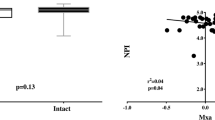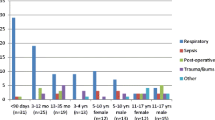Abstract
The effect of intravenous aminophylline (10 mg/kg) on cerebral blood flow (CBF) and single flash visual evoked potential (VEP) was investigated in 16 preterm infants (range 25–34 weeks). All infants were weaned from mechanical ventilation and had normal brain ultrasonograms. CBF, PaO2, PaCO2, mean arterial blood pressure and VEP were recorded before, immediately after and 1 h after the administration of aminophylline. When intra-individual changes in PaCO2 were taken into account, mean CBF was 5.5% lower than the baseline value immediately after administration of aminophylline, but this was not statistically significant (P=0.14). After 1 h, however, CBF had decreased by a mean of 13.8% (P=0.0003). The cerebral function estimated from VEP was not influenced by aminophylline since the VEP configuration and the VEP parameters remained constant throughout the study. It is concluded that aminophylline reduces cerebral blood flow in stable, preterm infants and apparently without inducing adverse effects on cerebral function.
Similar content being viewed by others
Abbreviations
- CBF:
-
cerebral blood flow
- MABP:
-
mean arterial blood pressure
- PaCO2 :
-
arterial carbon dioxide tension
- PaO2 :
-
arterial oxygen tension
- VEP:
-
visual evoked potential
References
Branston NM, Ladds A, Symon L, Wang AD (1984) Comparison of the effects of ischaemia on early components of somatosensory evoked potentials in brainstem, thalamus, and cerebral cortex. J Cereb Blood Flow Metab 4:468–481
Ghai V, Raju TNK, Kim SY, McCulloch KM (1989) Regional cerebral blood flow velocity after aminophylline therapy in premature newborn infants. J Pediatr 114:870–873
Godfrey K (1986) Simple linear regression in medical research. In: Bailar JC, Mosteller F (eds) Medical uses of statistics. N Engl J Med 170–201
Greisen G (1986) Cerebral blood flow in preterm infants during the first week of life. Acta Paediatr Scand 75:43–51
Greisen G, Pryds O (1988) Intravenous133Xe clearance in preterm neonates with respiratory distress. Internal validation of CBF as a measure of global cerebral blood flow. Scand J Clin Lab Invest 48:673–678
Lassen NA (1974) Control of cerebral circulation in health and disease. Circ Res 34:749–760
Levene M, Shortland D, Gibson N, Evans DH (1988) Carbon dioxide reactivity of the cerebral circulation in extremely premature infants: effects of postnatal age and indomethacin. Pediatr Res 24:175–179
Magnussen I, Høedt-Rasmussen K (1977) The effect of intraarterial administered aminophylline on cerebral hemodynamics in man. Acta Neurol Scand 55:131–137
Minutillo C, Drayton M (1987) The effect of aminophylline on cerebral haemodynamics. International conference on Doppler ultrasound in the newborn, Leicester, UK (Abstract)
Obrist W, Thompson HK, Wang HS, Wilkinson HE (1975) Regional cerebral blood flow estimated by133Xenon inhalation. Stroke 6:245–256
Pryds O, Greisen G, Trojaborg W (1988) Visual evoked potentials in preterm infants during the first hours of life. Electroencephalogr Clin Neurophysiol 71:257–265
Pryds O, Greisen G, Lou H, Friis-Hansen B (1989) Heterogeneity of cerebral vasoreactivity in preterm infants supported by mechanical ventilation. J Pediatr 115:638–645
Pryds O, Andersen GE, Friis-Hansen B (1990) Cerebral blood flow reactivity in spontaneously breathing, preterm infants shortly after birth. Acta Paediatr Scand 79:391–396
Rosenkrantz TS, Oh W (1984) Aminophylline reduces cerebral blood flow velocity in low-birth-weight infants. Am J Dis Child 138:489–491
Saliba E, Autret E, Gold F, Bloc D, Pourcelot L, Laugier J (1989) Effect of caffeine on cerebral blood flow in preterm infants. Biol Neonate 56:198–203
Smith EO (1987) Analysis of repeated measures designs (Editorial). J Pediatrics 111:723–725
Van Bel F, Van de Bor M, Stijnen T, Baan J, Ruys JH (1989) Does caffeine affect cerebral blood flow in the preterm infant? Acta Paediatr Scand 78:205–209
Wechsler RL, Kleiss LW, Kety SS (1950) The effect of intravenously administrated aminophylline on cerebral circulation and metabolism in man. J Clin Invest 29:28–30
Author information
Authors and Affiliations
Rights and permissions
About this article
Cite this article
Pryds, O., Schneider, S. Aminophylline reduces cerebral blood flow in stable, preterm infants without affecting the visual evoked potential. Eur J Pediatr 150, 366–369 (1991). https://doi.org/10.1007/BF01955942
Received:
Accepted:
Issue Date:
DOI: https://doi.org/10.1007/BF01955942




